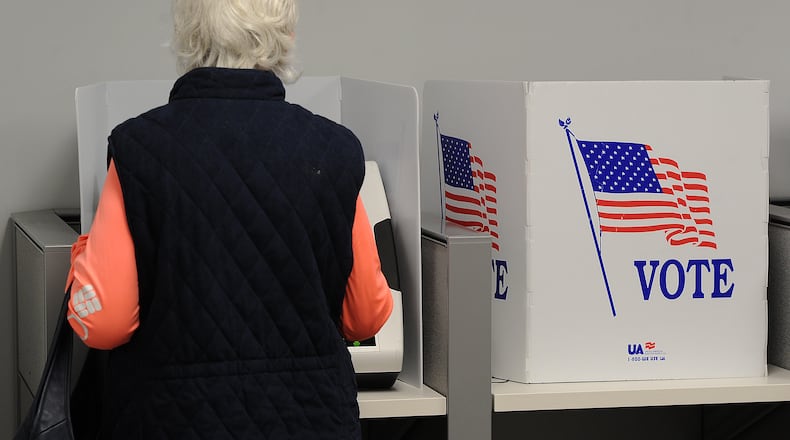“These registrations are eligible for removal under the law because records show they’re no longer residing or active at the registered address for at least the last four consecutive years,” said LaRose in a news release announcing the roster.
“This list has been provided to my office by the county boards of elections after meticulous work under bipartisan oversight. We’re at the last stage of the process, where anyone can now check the list and contact their board of elections if they want to reactivate their registration or if they believe their record might be listed in error.”
People on the removal list whose voter registrations are deemed inactive and who have not responded to notifications from their county board of elections include:
- People who have not voted or engaged in any other elections activity, such as signing elections petitions or applying for an absentee ballot, in at least four years.
- Those who filed a change of address with the U.S. Postal Service National Change of Address registry but did not update their address on their voter registration.
- People who registered to vote at an address, but an acknowledgment notice mailed to that address by the county board of elections was returned as undeliverable.
- Those whose voter registration information doesn’t match records kept by the Ohio Bureau of Motor Vehicles.
- People who died.
Voters whose registrations are improperly identified for removal must take action before July 22. They can remain on the voter registration rolls by confirming or updating address and registration information online at VoteOhio.gov or by mail or in-person at their county board of elections office, according to LaRose’s office.
They also can confirm and update their address at the Ohio Bureau of Motor Vehicles or engage in elections activity.
Those whose names are removed from the vote rolls are free to register to vote at their current address, but must do it by the voter registration deadline before Election Day. Oct. 7 is the voter registration deadline for this year’s Nov. 5 election.
“Ohio’s voter list maintenance procedures have been administered by bipartisan election officials for at least the last 30 years, since the passage of the National Voter Rights Act,” LaRose said in a May news release.
Credit: Todd Yarrington
Credit: Todd Yarrington
Some critics denounced LaRose for removing names of registered voters in advance of the November General Election.
“Even after the extremely aggressive voter purges before last November’s election that eliminated thousands of registered voters, Secretary LaRose has decided to double down and kick even more Ohioans off of the rolls,” state Sen. Bill DeMora, D-Columbus, said in a May news release. “The fact that Ohio has such safe and fair elections is purely despite our Secretary of State, not because of him!”
Maki Somosot, spokeswoman for a statewide group of organizations pushing for the Ohio Voters Bill of Rights, accused LaRose of targeting voters of color and said many slated to be removed from the roles are registered in Ohio counties with large minority populations, including Franklin, Hamilton and Cuyahoga counties.
“This upcoming voter purge further reinforces the need to protect voting rights into the Ohio state constitution,” Somosot said in a June news release. “Instituting same-day voter registration will also enable thousands more Ohioans to vote, including those whose voter registrations might be purged or canceled due to assumed inactivity.”
LaRose Press Secretary Ben Kindel responded by saying the registration removal process is “essential for election integrity.”
“This intentional spreading of disinformation is wrong and only serves to erode public trust. There is nothing controversial about removing an out-of-date registration left behind by a voter who has moved,” Kindel said.
Aaron Ockerman, executive director Ohio Association of Election Officials, said voting rights groups sometimes mail information to people on the list of names slated for removal to let them know they need to take action.
But, he said, people on the registration removal list typically have already received multiple notifications from the county board of elections at the address where they are registered. If the person responds to the notifications, updates or confirms their address, votes in any election or engages in elections activity they remain registered, Ockerman said.
He described how the process works for people who are on the list because they have not engaged in elections activity.
The four-year period for inactive voting begins with the first time a person fails to vote in a federal election, Ockerman said. So a person who voted in the federal election in 2020 but not in 2022 would get a notification from their county board of elections in 2023, sent to the address where they are registered, that they are in “confirmation status” and asking if they want to remain registered.
If that person does not respond, and does not vote in any election, including the 2024 federal election, they would receive notification that their voter registration will be canceled in 2026, unless they take action, Ockerman said.
“These people have not responded for four years and not responded to the final notice,” he said. “It’s six years from the last time we can show (election) activity.”
Follow @LynnHulseyDDN on Facebook, Instagram, TikTok and X.
About the Author


